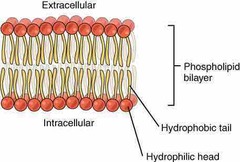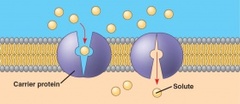![]()
![]()
![]()
Use LEFT and RIGHT arrow keys to navigate between flashcards;
Use UP and DOWN arrow keys to flip the card;
H to show hint;
A reads text to speech;
20 Cards in this Set
- Front
- Back
- 3rd side (hint)
|
Cell Membrane |
- Allows certain things in and out (semi-permeable) - The movement of matter in and out of the cell allows cells to survive as individual units of life. - It’s made up of a double layer of phospholipids. - The double layer is often referred to as the phospholipid bilayer |

|
|
|
Phospholipid |
- Two make up the phospholipid bilayer of the cell membrane - Head = Hydrophilic = loves water - orients towards water. Made of nitrogen, phosphate, glycerol. - Tail = Hydrophobic = fears water - orients away from water. Made of fatty acids |
|
|
|
Fluid Mosaic Model |
- Represents the movement of cell membranes. - Fluid: membrane and sub-units move and flow; dynamic - Mosaic: membranes have a variety of sub-units (proteins. lipids) embedded into them |
|
|
|
Purposes of the cell membrane: 1/3 Transportation |
channels/bridges |
|
|
|
2/3 Helps identify cells |
- Have markers (antigens) which are used to identify them - Immune system relies on them to detect foreign cells |
|
|
|
3/3 Transmission of chemical signals/messages |
- Hormones attach to receptor proteins - Hormone attaches to cell membrane proteins and cause the cell to increase the uptake of sugar from the blood |
|
|
|
Semipermeable |
- Lets smaller molecules in easier - Non charged chemicals move easier than charged - Membrane proteins move larger/charged substances across w/ transporter proteins |
Ex. Glucose can only get across w/ transporter proteins |
|
|
Brownian motion |
Movement of particles in liquid/air is random. |
|
|
|
Equalibrium |
When particles keep spreading out via diffusion until they're balanced. |
|
|
|
Concentration Gradient |
The separation between an area of high/low concentration (could be with osmosis or diffusion). |
|
|
|
Passive Transport |
The movement of a particle without the use of energy (ATP) |
|
|
|
3 Types of Passive Movement |
- Diffusion - Facilitated Diffusion - Osmosis |
|
|
|
Diffusion |
- Particles tend to move from high to low concentration - This separation creates a concentration gradient |
|
|
|
Facilitated Diffusion |
- When a particle is too big/has a charge to it so it relies on transport proteins to help them - 2 types of proteins it transports: channel (charge) and carrier (size) proteins |

|
|
|
Channel Proteins (for moving charged particles; ions) |
- have tunnels/pores |
|
|
|
Carrier Proteins (for moving larger particles) |
- have specific 3D shape - when correct shape enters, protein changes shape (opens) - as the protein moves, it releases the particle onto the other side of the membrane |

|
|
|
Osmosis |
- refers to the diffusion of water molecules across a membrane (wants to move to the side w/ more solute) |
|
|
|
Hypotonic |
- the cell has a lower solute concentration than the solution on the other side of the membrane - hypotonic solutions lose water --> cell gains water (swells) |
|
|
|
Hypertonic |
- the cell has a higher solute concentration than the solution on the other side of the membrane - hypertonic solutions gain water --> cell loses water (shrinks) |
|
|
|
Isotonic |
- no net gain or loss = equilibrium |
|

